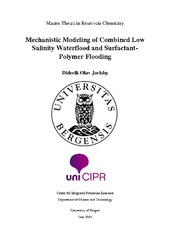Mechanistic Modeling of Combined Low Salinity Waterflood and Surfactant- Polymer Flooding
Master thesis
Permanent lenke
https://hdl.handle.net/1956/18460Utgivelsesdato
2018-06-27Metadata
Vis full innførselSamlinger
Sammendrag
Flooding experiments have been made to investigating the effects of low salinity brine injection and the combined injection of low salinity surfactant and low salinity polymer solutions. These experiments have shown a large increase in oil recovery compared to traditional, high salinity brine injection. This thesis is a study into the modeling of these hybrid EOR experiments. The thermal & advanced process simulator STARS from CMG was utilized in mechanistic modeling of low salinity, surfactant and polymer flooding. A history match of differential pressure and oil production was performed to evaluate the functionality of STARS. Wettability alteration was modeled through salinity dependent water/oil relative permeability curves while capillary number was utilized as an interpolation parameter for surfactant relative permeability curves. Due to issues handling a third interpolation parameter, polymer could not be rendered with a dedicated relative permeability set. Instead, its effects were modeled through viscosity, adsorption and inaccessible pore volume. A new approach to modeling multi- dimensional relative permeability interpolation was investigated. Several aspects were deemed viable, but the presented way of modeling relative permeability of a third component was found to be unusable for the current approach to history matching. The results showed that the underlying mechanisms of low salinity injection are more complex than wettability alteration alone. Additionally, the low salinity polymer flood and subsequent low salinity waterflood were insufficiently rendered by the current model.
